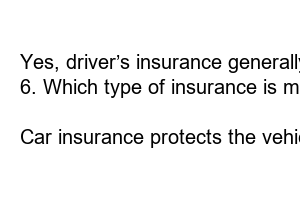자동차보험 운전자보험 차이
Title: The Key Differences between Car Insurance and Driver’s Insurance Explained
Introduction:
Car insurance and driver’s insurance are often confused, leading to misunderstandings when it comes to coverage and liability. Although related, car insurance and driver’s insurance are distinct in their focus and the benefits they offer. In this article, we will dissect the differences between these two types of insurance, helping you make more informed decisions to protect your vehicle and yourself on the road.
1. Understanding Car Insurance:
Car insurance primarily revolves around protecting your vehicle against various risks, such as accidents, theft, or damage caused by natural disasters. It involves policies that safeguard your car, whether you are the driver or not.
2. Unraveling Driver’s Insurance:
Driver’s insurance, on the other hand, is focused on covering the person behind the wheel – you, as the driver. It offers a safety net should you cause an accident or suffer injuries while driving someone else’s car. This type of insurance is particularly useful if you frequently borrow or rent vehicles.
3. Liability Coverage:
Car insurance typically encompasses liability coverage, which protects you if you are found at fault in an accident that resulted in damage to property or injury to another person. This covers the expenses associated with medical bills, legal fees, and property repair or replacement.
4. Personal Injury Protection (PIP):
One key difference between car insurance and driver’s insurance is PIP, a feature typically included in driver’s insurance policies. PIP covers your medical bills, lost wages, and other related expenses resulting from an accident, regardless of who is at fault.
5. Vehicle Coverage Options:
Car insurance policies offer various vehicle-specific coverage options like comprehensive, collision, and uninsured/underinsured motorist coverage. These options are not found in driver’s insurance policies since they primarily focus on the driver rather than the specific vehicle.
6. Premium Determination:
Car insurance premiums mainly depend on vehicle factors such as make, model, age, and safety features. In contrast, driver’s insurance focuses on the driver’s personal information, like their driving history, age, and location, to determine premiums.
FAQs:
1. Does car insurance cover me when I drive someone else’s car?
No, car insurance covers the vehicle rather than the driver. If you frequently drive other people’s cars, consider obtaining driver’s insurance to safeguard yourself adequately.
2. Can I have both car insurance and driver’s insurance?
Yes, you can have both types of insurance. This provides comprehensive coverage, protecting your vehicle and yourself as the driver in various scenarios.
3. What happens if someone else drives my car and gets into an accident?
If you have comprehensive car insurance, your policy may cover the damages. However, if the driver is not listed on your policy, their driver’s insurance may also come into play.
4. Is driver’s insurance required by law?
While car insurance is typically legally mandated, driver’s insurance is not mandatory in all states. However, it is highly recommended to supplement your coverage and protect yourself as a driver.
5. Can I use my driver’s insurance on any vehicle?
Yes, driver’s insurance generally covers you regardless of the vehicle’s ownership, as long as you have permission to drive it.
6. Which type of insurance is more expensive?
The cost of insurance depends on multiple factors, including the type of coverage, your driving record, and the type of vehicle. Comparing quotes from different insurers can help you identify the most cost-effective option for your situation.
Summary:
Car insurance protects the vehicle from risks, while driver’s insurance covers the person behind the wheel. Car insurance offers liability coverage and vehicle-specific options, while driver’s insurance often includes personal injury protection (PIP) and is focused on the driver’s personal information. Obtaining both types of insurance can provide comprehensive coverage to protect both your vehicle and yourself as the driver on the road.

